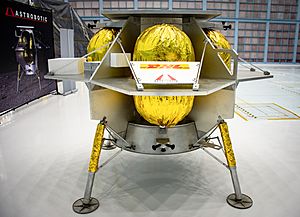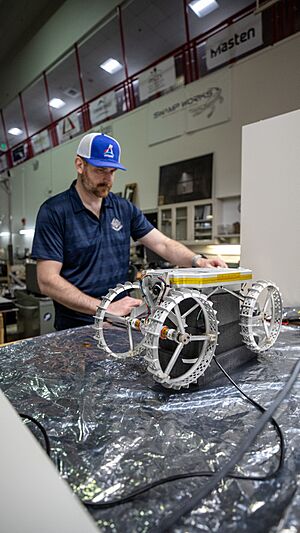Astrobotic Technology facts for kids
 |
|
| Private company | |
| Industry |
|
| Founded | 2007 |
| Headquarters |
Pittsburgh, Pennsylvania, U.S.
|
|
Key people
|
|
| Products |
|
|
Number of employees
|
130 (As of 2023[update]) |
Astrobotic Technology, Inc., often called Astrobotic, is an American company. They create robots and technology for missions to the Moon and other planets. It was started in 2007 by Red Whittaker, a professor from Carnegie Mellon University, and his team. Their first big goal was to win the Google Lunar X Prize. The company is located in Pittsburgh, Pennsylvania.
Astrobotic's first launch happened on January 8, 2024. This was part of NASA's Commercial Lunar Payload Services (CLPS) program. Their Peregrine lunar lander was carried by the first Vulcan Centaur rocket from Cape Canaveral Space Force Station in Florida. Sadly, the mission could not reach the Moon for a landing.
On June 11, 2020, Astrobotic received another contract for the CLPS program. NASA was going to pay Astrobotic US$199.5 million to take the VIPER rover to the Moon. This mission was planned for November 2024. However, in July 2024, NASA announced that the VIPER mission was canceled.
Contents
Astrobotic's Journey to Space
Early Goals and NASA Support
In 2007, Astrobotic announced its goal to be the first private company to land on the Moon. That same year, they built a working model of a spacecraft called Red Rover. They also changed the name of their planned lander from Artemis Lander to Griffin.
In July 2008, NASA gave Astrobotic money to study how to move lunar soil, called regolith. The next year, Astrobotic received more funding from NASA. This money was for researching lunar resources, which led to an idea for a machine called Polar Excavator.
NASA continued to support Astrobotic with contracts. In October 2010, NASA awarded Astrobotic a contract worth up to US$30.1 million over five years. In December 2010, Astrobotic received another US$500,000 from NASA for lunar demonstrations.
Developing New Technologies
Astrobotic also worked on ideas for exploring lunar caves and lava tubes. In April 2011, they received a US$599,000 contract. This was to develop a device that could simulate lunar gravity for testing rovers.
In May 2012, John Thornton became the new President of Astrobotic.
On April 30, 2014, NASA chose Astrobotic Technology as one of three companies for its Lunar CATALYST program. This program involved a partnership where Astrobotic's Griffin lander might be used. The agreement was extended in October 2017.
Designing the Peregrine Lander
On June 2, 2016, Astrobotic Technology revealed a new design for its Griffin lander. They named it Peregrine. Airbus Defence and Space agreed to help Astrobotic improve the lander's design. In December 2016, Astrobotic moved its estimated launch date to 2019. They also decided to leave the Google Lunar X Prize competition.
On November 29, 2018, Astrobotic became eligible to bid on NASA's Commercial Lunar Payload Services (CLPS) program. This program delivers science and technology tools to the Moon. Astrobotic won a US$79.5 million contract to deliver payloads to Lacus Mortis. They initially planned to launch 14 payloads starting in July 2021.
In September 2019, Spacebit signed an agreement to send the first UK lunar rover, Asagumo, on Astrobotic's mission. This was called "Spacebit mission one".
John Thornton, Astrobotic's CEO, was named CEO of the Year in September 2019. This award was given by the Pittsburgh Technology Council.
In January 2021, MrBeast, a famous YouTuber, announced he would send a payload on the Peregrine lander. This payload was a hard drive filled with digital images from people who paid US$10.
Recent Developments and Challenges
In June 2021, the first flight of the Vulcan Centaur rocket, carrying the first Peregrine lander, was delayed to 2022. This was due to delays in testing the payload and engine.
In November 2021, Astrobotic Technology was recognized as one of the "World's Best Employers in the Space Industry."
In September 2022, Astrobotic bought Masten Space Systems. Masten had faced financial difficulties. Masten became Astrobotic's "Propulsion and Test Department." They continued to develop Masten's Broadsword 3D-printed engine.
Problems during a test on December 8, 2023, delayed the first Vulcan Centaur flight until 2024.
The Peregrine lander launched on January 8, 2024. It took off from Florida's Space Force Station LC-41. A fuel leak prevented it from reaching the Moon. The mission stayed in Earth's orbit and ended with a controlled re-entry into Earth's atmosphere on January 18, 2024.
In 2024, the company announced its ‘Luna Grid’ service. This service aims to provide steady power on the Moon's surface. It uses Astrobotic's landers and rovers with special solar panels.
Astrobotic's Missions
Past Missions and Plans
Canceled Missions
- In April 2011, Astrobotic planned a mission to the Moon's lunar north pole with SpaceX. This mission, first called Polar Excavator and then Icebreaker, was to launch the Griffin lander. It would carry a small rover and up to 110 kg of cargo. The launch date was delayed several times. Astrobotic partnered with other teams, Hakuto and Team AngelicvM, to share launch costs. They planned to send all their rovers on one SpaceX Falcon 9 v1.1 rocket using the Astrobotic Griffin lander. However, the Griffin lander was never built, and the Icebreaker mission did not launch.
- MoonRanger was a 13 kg rover designed to carry payloads on the Moon for NASA's CLPS program. Astrobotic and Carnegie Mellon University received a US$5.6 million contract for it in July 2019. MoonRanger was supposed to launch aboard Masten Mission One. This rover would have explored a polar region for signs of water ice or entrances to Moon caves. It would have operated mostly on its own for about a week. Masten Mission One was canceled after Masten Space Systems went bankrupt in 2022. So, MoonRanger did not get to fly to the Moon.
Peregrine Mission One
Peregrine Mission One was a lunar lander built by Astrobotic Technology. NASA chose it for its CLPS program. It launched on January 8, 2024, on a Vulcan Centaur rocket. The lander carried many different payloads, with a total weight capacity of 90 kg.
Peregrine was planned to land at Mons Gruithuisen Gamma. The mission could not reach the Moon for a soft or hard landing. It never left its original Earth orbit. The mission ended with a controlled re-entry into Earth's atmosphere on January 18, 2024.
Griffin Mission One
The Griffin lander is planned to land in the Moon's south polar region in September 2025. The spacecraft is expected to work for 100 days after landing. NASA's VIPER rover was supposed to be the main payload. VIPER was a 450 kg rover that would investigate dark areas of craters for water ice. This ice could be used by future human missions. However, the VIPER program was canceled in July 2024.
Other commercial payloads are still on board the Griffin lander. These include the Lunar Codex's Polaris archive, which holds modern culture items.
In March 2024, Astrobotic hired new leaders to help with the Griffin lander after the Peregrine lander's failure. Even though VIPER was canceled, NASA still plans to support the Griffin lander's arrival on the Moon in 2025. Instead of VIPER, Astrolab's FLIP rover will be on board. NASA expects other missions to achieve VIPER's goals in the coming years.
Griffin Mission Two
Griffin Mission Two is a planned mission set to launch in late 2026.
CubeRover
CubeRover is a type of planetary rover with a standard size and design. This design helps speed up space exploration. It's similar to the successful CubeSat format, where parts are compatible and inexpensive. Astrobotic Technology is developing the CubeRover concept with Carnegie Mellon University. NASA also helps fund this project. Andrew Horchler is the main scientist for the program.
The first CubeRover, a smaller rover called Iris, was developed by CMU students. It was planned to be sent to the Moon on Astrobotic's Peregrine lander. However, it was lost when Peregrine re-entered Earth's atmosphere and was never deployed.
See also
- Exploration of Mars
- Exploration of the Moon
- Lunar rover
- Mars rover



